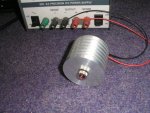- Joined
- Apr 2, 2009
- Messages
- 98
- Points
- 0
Is anyone making pulsed drivers for laser diodes or have a good design for one? Spec sheets often rate a 90mW CW 650nm diode much higher in pulsed mode, eg typically something like 200-250mW. Now, unless this description is misleading, 250mW pulsed (at however many Mhz) means 250mW true power, i.e. 0.25Watts/second on average at high rep rate. As far as the eye or any target is concerned this would be indistinguishable from 250mW 'true' CW.
I hope the 90mW V 250mW rating isn't just a CW verses peak 'nano-second' type power rating in other words a matter of manipulating the duty cycle. Perhaps it is but I haven't found a clear description or discussion of this. My thinking is that the diode junction can tolerate higher transient currents and possibly optical fluxes than it can contant currents and fluxes - hence there may be some way to squeeze more power out in pulsed mode. But ultimately I think I know the answer - the pulsed power rating is just the peak optical power (as is relevant for burning a DVD) and the mean power is still at or near the CW rating.
I hope the 90mW V 250mW rating isn't just a CW verses peak 'nano-second' type power rating in other words a matter of manipulating the duty cycle. Perhaps it is but I haven't found a clear description or discussion of this. My thinking is that the diode junction can tolerate higher transient currents and possibly optical fluxes than it can contant currents and fluxes - hence there may be some way to squeeze more power out in pulsed mode. But ultimately I think I know the answer - the pulsed power rating is just the peak optical power (as is relevant for burning a DVD) and the mean power is still at or near the CW rating.




